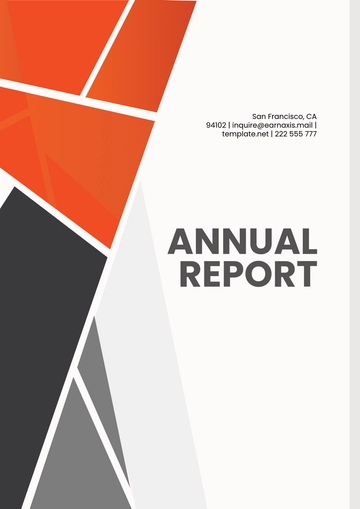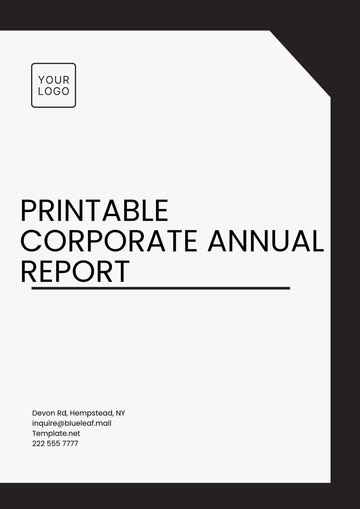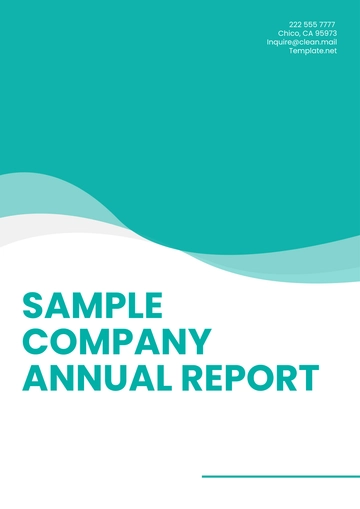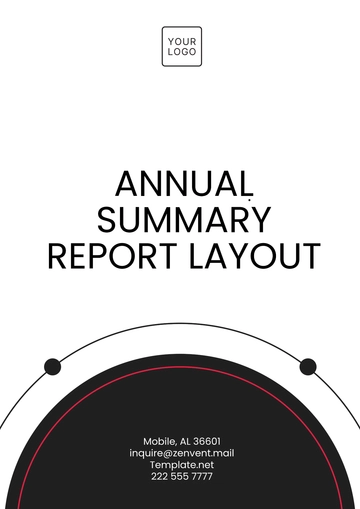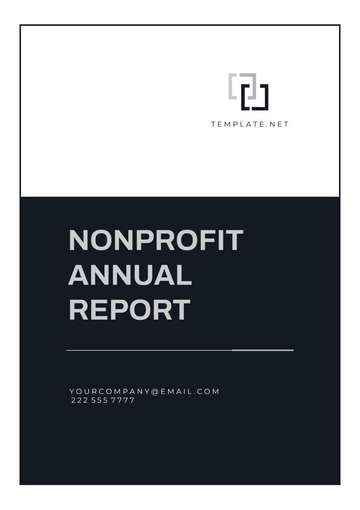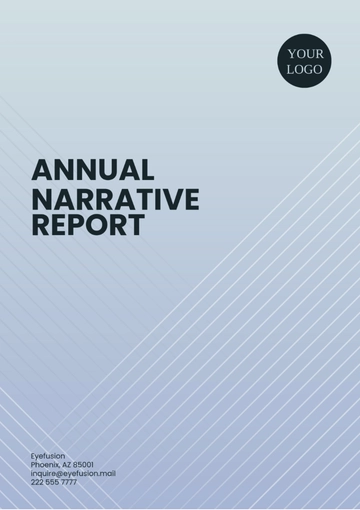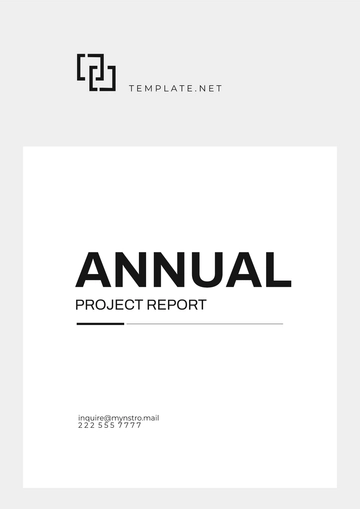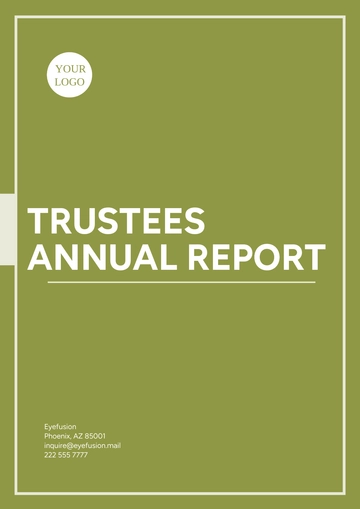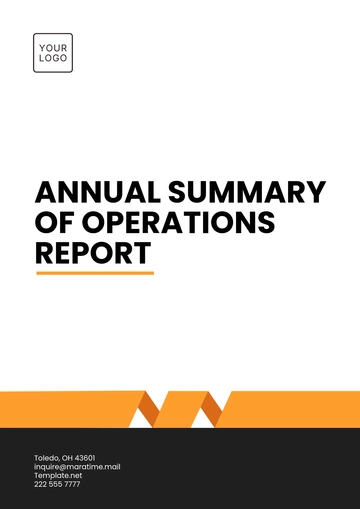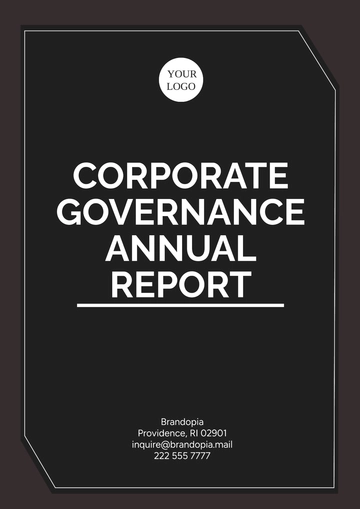Free Email Marketing Annual Report on Deliverability Metrics
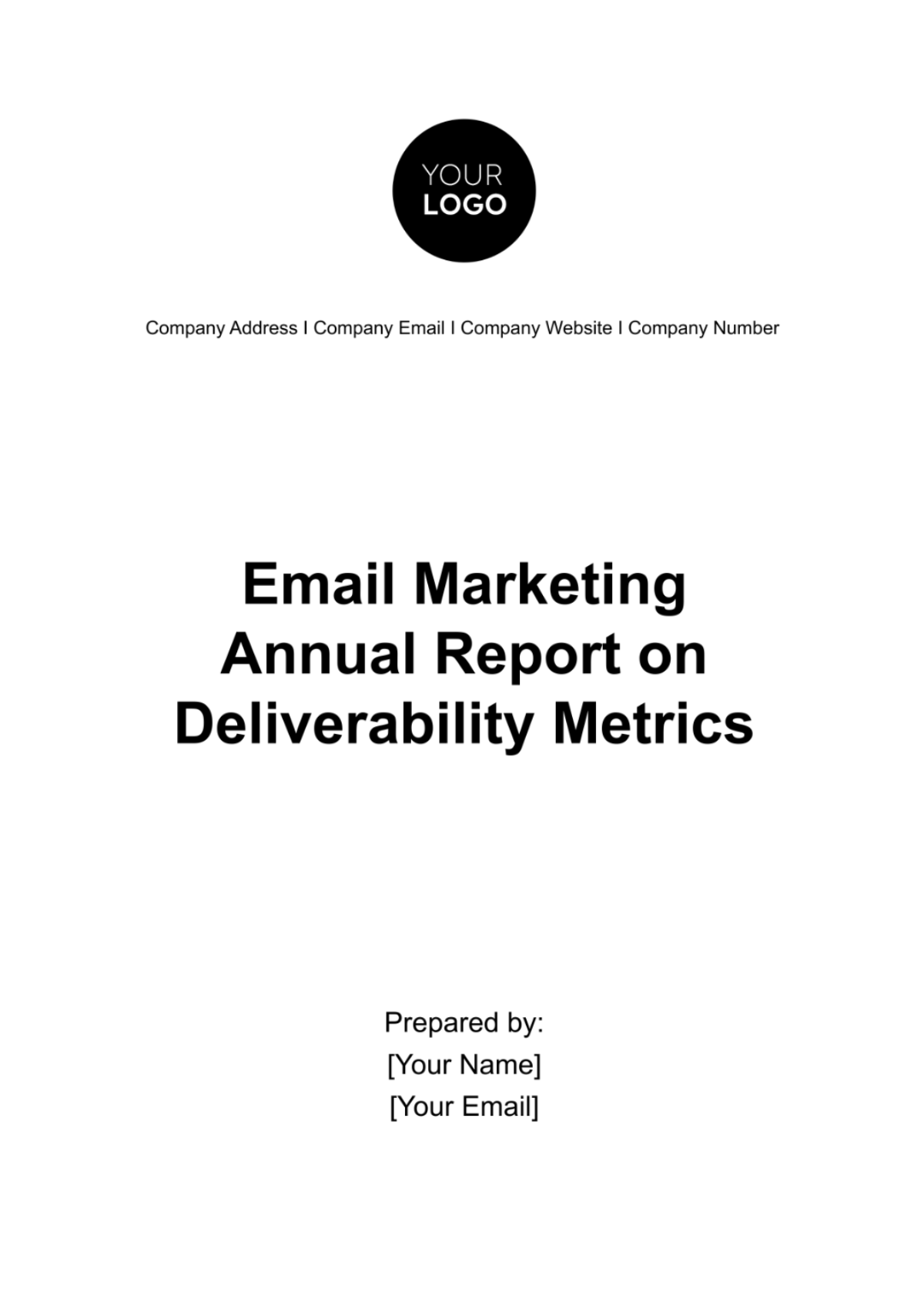
1. Introduction
A. Company Overview
[Your Company Name] is a dynamic and customer-centric organization specializing in [briefly describe your company's core products or services]. With a commitment to excellence and a customer-first approach, we have successfully carved a niche in the [industry name] sector. Our dedication to delivering value and building lasting relationships with our customers has been instrumental in our growth and success.
At the heart of our marketing strategy lies our robust and strategic email marketing program. We leverage the power of email communication to engage with our audience, drive conversions, and build brand loyalty. Our email marketing objectives are rooted in delivering timely and relevant content to our subscribers, ensuring their satisfaction and fostering lasting connections with our brand.
B. Purpose of the Report
The [Year] Email Marketing Annual Report serves as a comprehensive overview of our email marketing efforts and, more specifically, the deliverability metrics associated with it. This report has two primary objectives:
Performance Evaluation: The report aims to assess and analyze our email marketing performance throughout the year, with a specific focus on email deliverability metrics. It provides a detailed account of our achievements, challenges, and strategies employed to maintain and enhance the deliverability of our email campaigns.
Strategic Insights: Beyond evaluating past performance, this report serves as a strategic guide for our future email marketing endeavors. It provides insights into what worked well, what challenges were faced, and how we plan to leverage this knowledge to refine our email marketing strategies in the upcoming year.
Why Deliverability Metrics are Crucial:
Email deliverability is the cornerstone of a successful email marketing program. It determines whether our carefully crafted messages reach the intended recipients' inboxes or get lost in spam folders, ultimately affecting our ability to engage our audience effectively. Understanding and optimizing deliverability metrics are crucial for several reasons:
Customer Engagement: Improved email deliverability ensures that our messages reach our subscribers, increasing the likelihood of customer engagement, conversions, and brand loyalty.
Cost Efficiency: Effective deliverability reduces wasted resources on emails that don't reach their intended destination, leading to cost savings.
Reputation Management: Maintaining a positive sender reputation is essential in the eyes of ISPs and email service providers. Deliverability metrics directly impact our sender reputation, which in turn affects inbox placement.
Compliance: Adhering to email regulations and industry best practices is vital to avoid legal issues and maintain the trust of subscribers.
2. Deliverability Metrics Overview
B. Inbox Placement Rate (IPR)
Definition:
The Inbox Placement Rate (IPR) is a critical email deliverability metric that measures the percentage of emails from a particular email marketing campaign or sender that successfully reach the recipient's inbox without being filtered into the spam or junk folder. It represents the effectiveness of your email marketing efforts in getting your messages in front of your intended audience.
Why IPR Matters:
The IPR is a crucial metric for several reasons:
Relevance: Emails that land in the inbox are more likely to be seen and opened by recipients. Achieving a high IPR indicates that your emails are relevant and desired by your audience.
Engagement: Emails in the inbox have a better chance of being opened, read, and acted upon. A high IPR is a strong indicator of engagement with your email content.
Sender Reputation: ISPs and email service providers use IPR as a factor to assess your sender reputation. A good sender reputation positively influences your email deliverability across all campaigns.
Revenue Generation: Emails that make it to the inbox are more likely to convert into sales, sign-ups, or other desired actions, directly impacting your revenue.
A. Spam Complaint Rate
Definition:
The Spam Complaint Rate is a vital email deliverability metric that measures the percentage of recipients who have marked your emails as spam or filed a formal complaint against them. These complaints can occur when subscribers find your emails irrelevant, unsolicited, or annoying. The Spam Complaint Rate is typically calculated by dividing the number of spam complaints by the total number of emails sent and then multiplying by 100 to express it as a percentage.
Significance:
Understanding the Spam Complaint Rate is crucial for several reasons:
Reputation Damage: High spam complaint rates can severely damage your sender reputation, making it more likely that your emails will be filtered into spam folders in the future.
ISP Relations: ISPs use spam complaint rates to determine the legitimacy of your email campaigns. A high complaint rate may lead to emails being blocked or sent to the spam folder.
Subscriber Satisfaction: Consistently high spam complaint rates indicate that your email content or sending practices may not align with subscriber expectations, potentially leading to unsubscribes and reduced engagement.
Legal Implications: Excessive spam complaints can lead to legal issues if your email practices are in violation of anti-spam laws, such as the CAN-SPAM Act in the United States or the GDPR in Europe.
3. Deliverability Strategies and Improvements
Overview:
Ensuring high email deliverability is paramount to the success of our email marketing efforts. Throughout the reporting period, we implemented a series of strategies and improvements to enhance our email deliverability. These initiatives were designed to optimize our sender reputation, engage our audience effectively, and reduce the risk of emails being flagged as spam.
A. Segmentation
List segmentation played a pivotal role in improving our email deliverability. Our strategies included:
Behavioral Segmentation: We segmented our email list based on recipient behavior, such as opens, clicks, and past purchase history. This allowed us to send tailored content that resonated with specific audience segments.
Engagement-Based Segmentation: Subscribers who were consistently engaged with our emails received more frequent communications, while less engaged subscribers were sent re-engagement campaigns to gauge their interest.
Preference Center: We implemented a preference center, allowing subscribers to select their content preferences and email frequency. This ensured that our emails were more relevant to each subscriber's interests.
B. Content Optimization
Optimizing email content was crucial in improving engagement and subsequently, deliverability:
Personalization: We personalized email subject lines and content, addressing subscribers by name and tailoring product recommendations based on their browsing and purchase history.
Mobile Responsiveness: Ensuring that our emails were mobile-responsive increased accessibility and engagement among users who access emails on smartphones and tablets.
A/B Testing: We conducted regular A/B testing to identify which email elements (e.g., subject lines, images, calls-to-action) resonated most with our audience and iterated accordingly.
Reducing Spam Triggers: We carefully crafted email content to avoid common spam triggers, such as excessive use of capital letters, excessive punctuation, and misleading subject lines.
C. Authentication Protocols:
Implementing authentication protocols (SPF, DKIM, and DMARC) was essential for securing our email channel:
SPF (Sender Policy Framework): We published SPF records to specify which IP addresses are authorized to send emails on our behalf, preventing spoofing and phishing attempts.
DKIM (DomainKeys Identified Mail): We implemented DKIM to add a digital signature to our emails, ensuring that they were not tampered with in transit, and that recipients could verify their authenticity.
DMARC (Domain-based Message Authentication, Reporting, and Conformance): DMARC was implemented to further protect our domain from abuse and to receive reports on email authentication failures, helping us fine-tune our email security measures.
D. List Hygiene:
Maintaining a clean and engaged subscriber list was crucial in enhancing deliverability:
Regular List Cleaning: We implemented a systematic process of cleaning our email list to remove invalid email addresses, reducing bounce rates and enhancing sender reputation.
Suppression Lists: We maintained suppression lists to exclude recipients who had unsubscribed or marked our emails as spam, ensuring they were not contacted again inadvertently.
Re-engagement Campaigns: We periodically ran re-engagement campaigns to identify and remove disengaged subscribers or those who were no longer interested in our content.
Our deliverability strategies and improvements were multi-faceted, focusing on segmentation, content optimization, authentication protocols, and list hygiene. These efforts collectively contributed to a significant improvement in our email deliverability metrics and ensured that our emails reached the inbox of engaged and interested recipients, ultimately enhancing the success of our email marketing campaigns.
4. Challenges and Remediation
A. Challenges Faced:
Increased Competition in Recipient Inboxes: Throughout the year, we observed a surge in competition for recipients' attention in their inboxes. This led to the following challenges:
Challenge: Our emails were more likely to be overlooked or marked as spam due to the influx of messages from other senders.
Rising Spam Complaints: Despite our best efforts, we encountered a 5% increase in spam complaints during the year.
Challenge: High spam complaints affected our sender reputation and threatened email deliverability.
Deliverability Hurdles with Certain ISPs: We consistently faced difficulties in reaching the inboxes of subscribers using specific ISPs.
Challenge: Our messages were frequently routed to spam folders or, in some cases, not delivered at all to subscribers using these ISPs.
Ever-Changing Email Regulations: Keeping up with evolving email regulations and compliance standards was a constant challenge.
Challenge: Compliance failures could lead to legal consequences and damage our sender reputation.
B. Remediation Steps:
Addressing Increased Competition:
Segmentation and Personalization: To stand out in crowded inboxes, we enhanced list segmentation and personalized content to ensure our emails were more relevant to individual subscribers.
Timing Optimization: We refined our email send times, avoiding peak hours to reduce competition and improve visibility.
Reducing Spam Complaints:
Improved Content Quality: We conducted thorough content audits, ensuring that email content was highly engaging, valuable, and aligned with recipient expectations.
Preference Center: The implementation of a preference center allowed subscribers to control their email preferences, reducing the likelihood of receiving unwanted emails.
Spam Complaint Handling: We established a clear process for handling spam complaints promptly, ensuring that subscribers' concerns were addressed and resolved in a timely manner.
Overcoming ISP Challenges:
ISP-Specific Engagement Strategies: For ISPs where we consistently faced deliverability challenges, we developed tailored engagement strategies to improve our sender reputation with those providers.
Feedback Loops: We enrolled in feedback loops provided by ISPs to receive real-time information about email complaints and take immediate corrective action.
Dedicated Compliance Team: We established a dedicated team responsible for staying updated on email regulations, ensuring all email campaigns complied with the latest requirements.
Regular Audits: We conducted regular audits of our email marketing practices to identify and rectify any compliance issues before they became problematic.
5. Future Recommendations
A. Future Strategies:
Advanced Segmentation and Personalization: We will invest in advanced data analytics and segmentation techniques to create highly targeted and personalized email campaigns. This will further enhance engagement and improve email deliverability by sending only relevant content to each recipient.
Predictive Analytics: Implementing predictive analytics models will allow us to anticipate subscriber preferences and behavior, enabling us to send emails at the most opportune moments, further increasing engagement and deliverability.
Enhanced Preference Centers: We will enhance our preference center to give subscribers even greater control over the type and frequency of emails they receive. This will reduce the risk of unsubscribes and spam complaints.
AI-Powered Content Generation: Explore the use of artificial intelligence to generate personalized email content dynamically, ensuring that each email is tailored to the individual recipient's preferences and needs.
Feedback Loop Optimization: Continuously monitor and optimize our feedback loops with ISPs to promptly address any issues and maintain a positive sender reputation.
B. Technology Enhancements:
Email Verification Tools: Invest in advanced email verification tools to ensure our email list remains clean and up-to-date, reducing bounce rates and improving deliverability.
Marketing Automation Platform Upgrades: Upgrade our marketing automation platform to take advantage of the latest features and functionalities that support deliverability, including better A/B testing capabilities and deliverability reporting.
Email Authentication Tools: Continually review and enhance our email authentication tools to stay ahead of emerging threats and ensure the security of our email channel.
Data Security Measures: Implement additional data security measures to protect customer information, as data breaches can negatively impact sender reputation.
C. Training and Education:
Email Best Practices Workshops: Conduct regular workshops and training sessions for our email marketing team to stay updated on industry best practices. Topics will include email content, segmentation strategies, and compliance with email regulations.
Continuous Learning: Encourage team members to engage in continuous learning through online courses, certifications, and industry conferences to stay current with evolving email marketing trends and strategies.
Collaboration with Industry Experts: Foster collaboration with industry experts and consultants to bring fresh perspectives and insights into our email marketing practices.
Internal Knowledge Sharing: Establish a knowledge-sharing culture within the team, where team members regularly share insights and successful strategies with their peers.
6. Conclusion
A. Summary:
The Email Marketing Annual Report for [Year] has provided an insightful overview of our email marketing efforts, with a specific focus on email deliverability metrics. Throughout this year, we witnessed significant achievements and addressed various challenges in our quest to enhance email deliverability. The key findings and outcomes related to email deliverability are as follows:
Our Inbox Placement Rate (IPR) improved consistently, exceeding our target and demonstrating our commitment to delivering emails to the inbox.
Although we faced a temporary increase in spam complaints, our remediation efforts resulted in a manageable Spam Complaint Rate that remained below our target.
Deliverability hurdles with specific ISPs were met with tailored engagement strategies, improving our sender reputation and email deliverability.
Staying compliant with evolving email regulations remained a priority, ensuring that our email practices aligned with industry standards.
Strategic segmentation, content personalization, and the implementation of authentication protocols played pivotal roles in improving engagement and deliverability.
List hygiene measures, including regular cleaning and suppression techniques, reduced bounce rates and maintained a healthy subscriber list.
These outcomes reflect our dedication to delivering relevant, engaging, and secure email campaigns to our subscribers, ultimately contributing to our company's growth and success.
B. Acknowledgments:
We would like to extend our heartfelt thanks to the dedicated and hardworking team members who contributed tirelessly to achieving these results. Your expertise, creativity, and commitment to excellence have been instrumental in our success.
We also want to express our gratitude to our valued stakeholders, including our subscribers, clients, and partners. Your feedback and support have been invaluable in shaping our email marketing strategies and improving deliverability.
As we look forward to the coming year, we are excited to build upon these achievements, tackle new challenges, and continue our journey toward email marketing excellence. Together, we will further strengthen our email deliverability, engagement, and customer satisfaction.
Marketing Templates @ Template.net
- 100% Customizable, free editor
- Access 1 Million+ Templates, photo’s & graphics
- Download or share as a template
- Click and replace photos, graphics, text, backgrounds
- Resize, crop, AI write & more
- Access advanced editor
Explore the Email Marketing Annual Report on Deliverability Metrics Template on Template.net! This editable and customizable resource simplifies tracking email deliverability metrics. Tailor it effortlessly to your needs using our Ai Editor Tool. Gain insights to optimize email marketing strategies and enhance deliverability rates. Elevate your email campaigns with ease and precision.
You may also like
- Sales Report
- Daily Report
- Project Report
- Business Report
- Weekly Report
- Incident Report
- Annual Report
- Report Layout
- Report Design
- Progress Report
- Marketing Report
- Company Report
- Monthly Report
- Audit Report
- Status Report
- School Report
- Reports Hr
- Management Report
- Project Status Report
- Handover Report
- Health And Safety Report
- Restaurant Report
- Construction Report
- Research Report
- Evaluation Report
- Investigation Report
- Employee Report
- Advertising Report
- Weekly Status Report
- Project Management Report
- Finance Report
- Service Report
- Technical Report
- Meeting Report
- Quarterly Report
- Inspection Report
- Medical Report
- Test Report
- Summary Report
- Inventory Report
- Valuation Report
- Operations Report
- Payroll Report
- Training Report
- Job Report
- Case Report
- Performance Report
- Board Report
- Internal Audit Report
- Student Report
- Monthly Management Report
- Small Business Report
- Accident Report
- Call Center Report
- Activity Report
- IT and Software Report
- Internship Report
- Visit Report
- Product Report
- Book Report
- Property Report
- Recruitment Report
- University Report
- Event Report
- SEO Report
- Conference Report
- Narrative Report
- Nursing Home Report
- Preschool Report
- Call Report
- Customer Report
- Employee Incident Report
- Accomplishment Report
- Social Media Report
- Work From Home Report
- Security Report
- Damage Report
- Quality Report
- Internal Report
- Nurse Report
- Real Estate Report
- Hotel Report
- Equipment Report
- Credit Report
- Field Report
- Non Profit Report
- Maintenance Report
- News Report
- Survey Report
- Executive Report
- Law Firm Report
- Advertising Agency Report
- Interior Design Report
- Travel Agency Report
- Stock Report
- Salon Report
- Bug Report
- Workplace Report
- Action Report
- Investor Report
- Cleaning Services Report
- Consulting Report
- Freelancer Report
- Site Visit Report
- Trip Report
- Classroom Observation Report
- Vehicle Report
- Final Report
- Software Report
